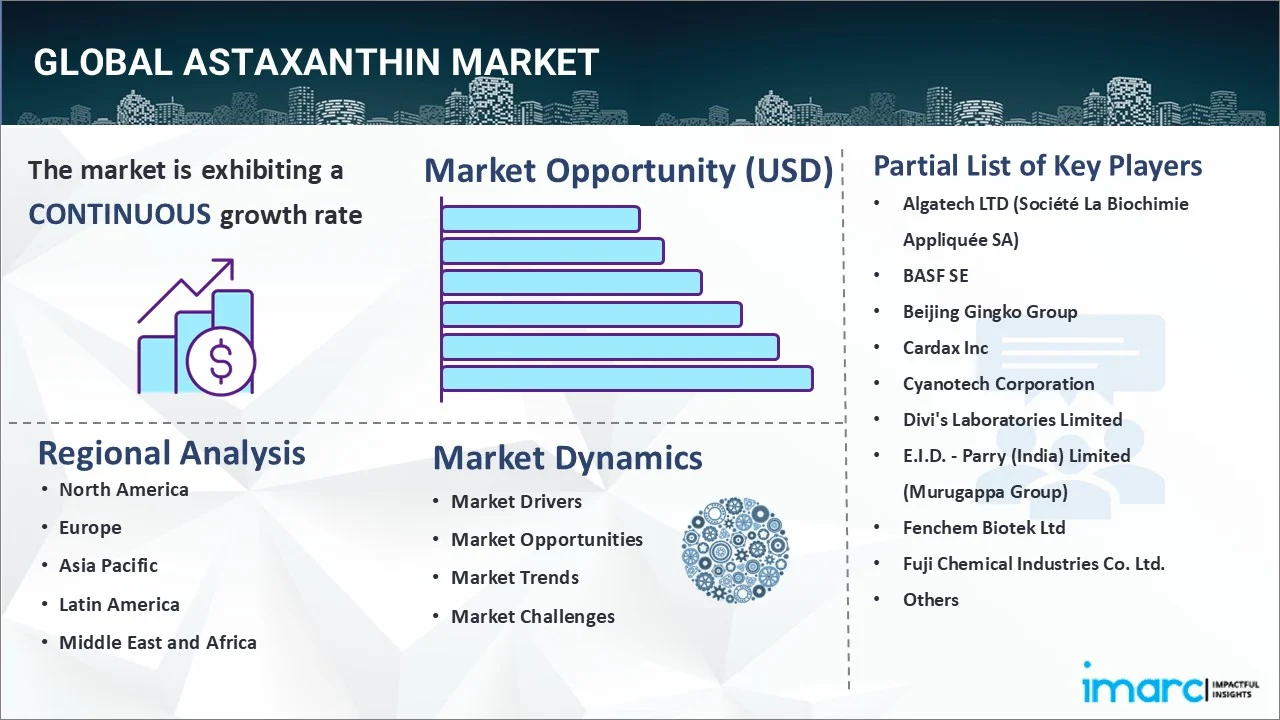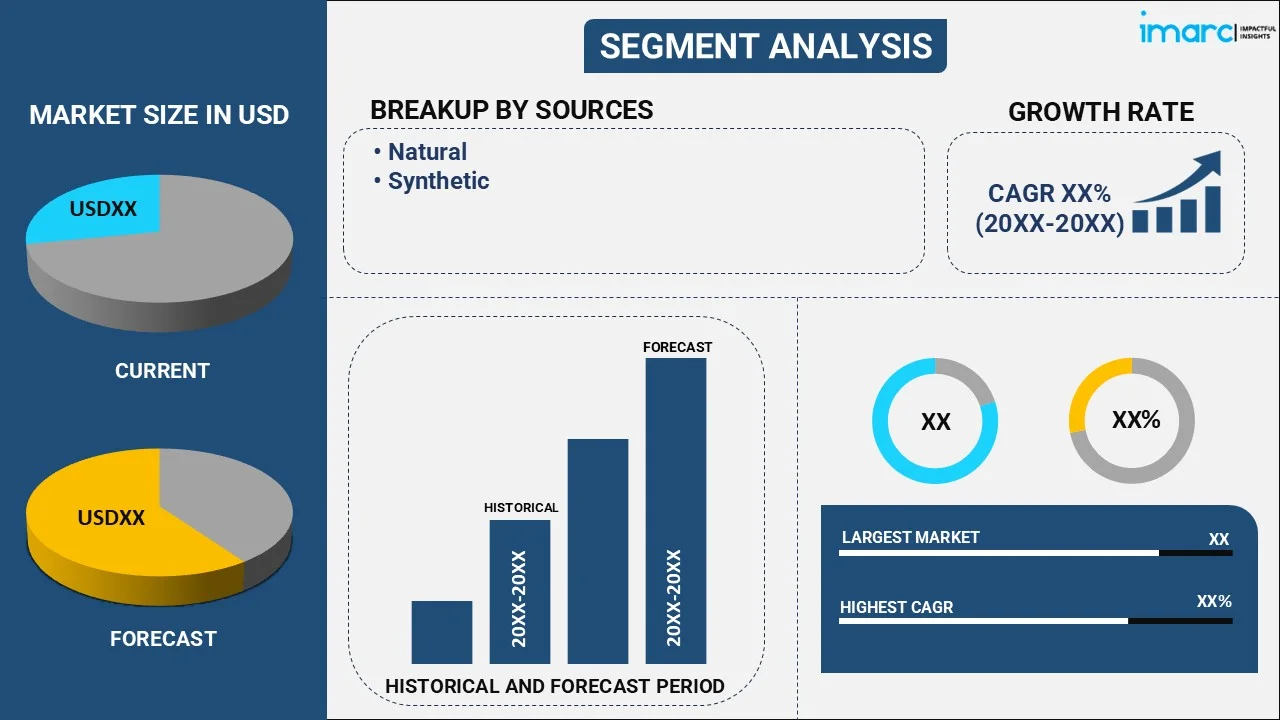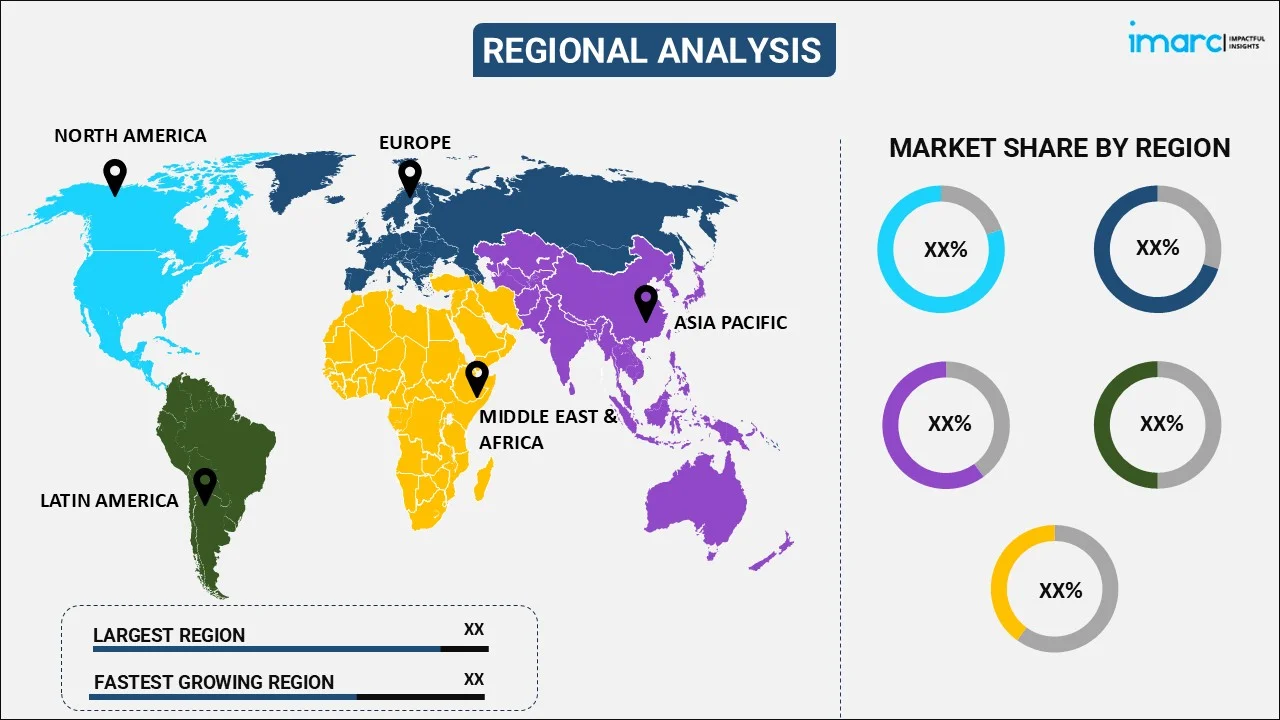
Astaxanthin Market Report by Source (Natural, Synthetic), Product (Dried Algae Meal or Biomass, Oil, Softgel, Liquid, and Others), Application (Nutraceuticals, Cosmetics, Aquaculture and Animal Feed, and Others), and Region 2025-2033
Global Astaxanthin Market:
The global astaxanthin market size reached USD 874.2 Million in 2024. Looking forward, IMARC Group expects the market to reach USD 1,628.8 Million by 2033, exhibiting a growth rate (CAGR) of 6.8% during 2025-2033. Aging population, the increasing consumer awareness of health and wellness, the growing demand for natural ingredients, and ongoing advancements in production technology, are primarily driving the market's growth.
|
Report Attribute
|
Key Statistics
|
|---|---|
|
Base Year
|
2024
|
|
Forecast Years
|
2025-2033
|
|
Historical Years
|
2019-2024
|
|
Market Size in 2024
|
USD 874.2 Million |
|
Market Forecast in 2033
|
USD 1,628.8 Million |
| Market Growth Rate (2025-2033) | 6.8% |
Astaxanthin Market Analysis:
- Major Market Drivers: The increasing prevalence of diseases like diabetes, cancer, cognitive health problems, and cardiovascular diseases, represents one of the significant factors propelling the growth of the market. Apart from this, various manufacturers are utilizing cost-effective technologies to reduce water wastage and save electricity, which is acting as another growth-inducing factor.
- Key Market Trends: The increasing preference for dietary supplements and rising nutritional deficiency among individuals are projected to bolster the market growth. Moreover, there is a significant rise in the demand for astaxanthin as a food-additive and food-coloring agent in the food and beverage (F&B) industry across the globe, further driving the industry's demand.
- Competitive Landscape: Some of the prominent astaxanthin market companies include Algatech LTD (Société La Biochimie Appliquée SA), BASF SE, Beijing Gingko Group, Cardax Inc, Cyanotech Corporation, Divi's Laboratories Limited, E.I.D. - Parry (India) Limited (Murugappa Group), Fenchem Biotek Ltd, Fuji Chemical Industries Co. Ltd., Koninklijke DSM N.V., and Piveg Inc., among many others.
- Geographical Trends: According to the astaxanthin market dynamics, Asia Pacific exhibits a clear dominance in the market. The expanding middle class in countries, such as China and India, is increasingly spending on health supplements, including astaxanthin.
- Challenges and Opportunities: High production costs associated with astaxanthin, and a limited supply of high-quality raw materials are hampering the market's growth. However, the increasing consumer awareness about the health benefits of astaxanthin presents an opportunity for market expansion.

Astaxanthin Market Trends:
Rising Elderly Population
The growing elderly population is driving the market's growth. For instance, by 2030, one in every six persons in the world will be 60 or older. At this time, the proportion of the population aged 60 and up will rise from 1 billion in 2020 to 1.4 billion. The global aging population is increasing the demand for supplements that can improve quality of life and mitigate age-related health issues. Astaxanthin's anti-aging properties make it a popular choice among older consumers. These factors are expected to propel the astaxanthin market in the coming years.
Growing Skincare Industry
The growing skincare industry is a significant driver of astaxanthin market growth. For instance, according to IMARC, the China skincare market size reached US$ 46.3 Billion in 2023. Looking forward, IMARC Group expects the market to reach US$ 98.3 Billion by 2032, exhibiting a growth rate (CAGR) of 8.5% during 2024-2032. Astaxanthin is well-known for its powerful antioxidant properties, which help combat oxidative stress and neutralize free radicals. This makes it a valuable ingredient in anti-aging skincare products. It can reduce the appearance of fine lines and wrinkles, making it popular in formulations aimed at mature skin. These factors further positively influence the astaxanthin market forecast.
Product Innovations
The skincare industry is continuously innovating with new products and formulations. Astaxanthin is being incorporated into a wide range of products, including serums, moisturizers, and masks, expanding its market reach. For instance, in June 2024, Embryolisse introduced Soin Blush de Peau Abricot Lumière, a detoxifying gel-cream that provides an instant healthy glow to the face and eye contour. The shade Abricot Lumiere is made with a combination of red pigments obtained from organic astaxanthin, thereby boosting the astaxanthin market revenue.
Global Astaxanthin Industry Segmentation:
IMARC Group provides an analysis of the key trends in each segment of the global astaxanthin market report, along with forecasts at the global, regional, and country levels from 2025-2033. Our report has categorized the market based on source, product, and application.
Breakup by Source:

- Natural
- Yeast
- Krill/Shrimp
- Microalgae
- Others
- Synthetic
Synthetic holds the majority of the total market share
The report has provided a detailed breakup and analysis of the astaxanthin market based on the source. This includes natural (yeast, krill/shrimp, microalgae, and others), and synthetic. According to the report, synthetic holds the majority of the total market share.
According to the astaxanthin market outlook, synthetic astaxanthin is often more affordable to produce compared to its natural counterparts, which are derived from microalgae or other natural sources. This cost advantage makes synthetic astaxanthin attractive for use in various applications, including supplements, cosmetics, and functional foods. Moreover, this can be tailored to meet specific requirements for different applications, such as dietary supplements, cosmetics, and animal feed. This customization allows for greater flexibility in product formulation.
Breakup by Product:
- Dried Algae Meal or Biomass
- Oil
- Softgel
- Liquid
- Others
Dried algae meal or biomass currently exhibits a clear dominance in the market
The report has provided a detailed breakup and analysis of the astaxanthin market based on the product. This includes dried algae meal or biomass, oil, softgel, liquid, and others. According to the report, dried algae meal or biomass currently exhibits a clear dominance in the market.
According to the astaxanthin market overview, dried algae biomass, particularly from microalgae such as Haematococcus pluvialis, is the primary source for natural astaxanthin. This algae strain is known for its high astaxanthin content, making it a key raw material in the production of natural astaxanthin. Moreover, the cultivation of algae for astaxanthin production is generally considered more sustainable compared to other methods. Algae can be grown in controlled environments with minimal impact on land and water resources, aligning with the increasing consumer demand for sustainable and eco-friendly products.
Breakup by Application:
- Nutraceuticals
- Cosmetics
- Aquaculture and Animal Feed
- Others
Aquaculture and animal feed accounts for the largest market share
A detailed breakup and analysis of the astaxanthin market based on the application has also been provided in the report. This includes nutraceuticals, cosmetics, aquaculture and animal feed, and others. According to the report, aquaculture and animal feed account for the largest market share.
Astaxanthin is widely used in aquaculture to enhance the coloration of fish and seafood, particularly in species like salmon, trout, and shrimp. It imparts a vibrant pink or red hue, which is highly valued by consumers and often associated with freshness and quality. Moreover, the increasing global demand for seafood drives the need for aquaculture products that meet consumer preferences for appearance and quality. Astaxanthin is crucial for achieving the desired color and health benefits.
Breakup by Region:

- North America
- United States
- Canada
- Asia-Pacific
- China
- Japan
- India
- South Korea
- Australia
- Indonesia
- Others
- Europe
- Germany
- France
- United Kingdom
- Italy
- Spain
- Russia
- Others
- Latin America
- Brazil
- Mexico
- Others
- Middle East and Africa
Asia-Pacific currently dominates the global market
The report has also provided a comprehensive analysis of all the major regional markets, which include North America (the United States and Canada); Europe (Germany, France, the United Kingdom, Italy, Spain, Russia and others); Asia Pacific (China, Japan, India, South Korea, Australia, Indonesia, and others); Latin America (Brazil, Mexico, and others); and the Middle East and Africa. According to the report, Asia-Pacific currently dominates the global market.
According to the astaxanthin market statistics, the growing health awareness among consumers in Asia Pacific is driving demand for dietary supplements and functional foods that offer health benefits. Astaxanthin, known for its powerful antioxidant properties, fits well into this trend. Apart from this, the aging population in countries like Japan, China, and other Asian countries is seeking products that support healthy aging and improve quality of life. For instance, in 2019, China had 254 million people aged 60 or older. By 2040, this figure is predicted to rise to 402 million, accounting for around 28% of the population. Astaxanthin's benefits for skin health, eye health, and overall wellness are attractive to this demographic.
Competitive Landscape:
The market research report has provided a comprehensive analysis of the competitive landscape. Detailed profiles of all major market companies have also been provided. Some of the key players in the market include:
- Algatech LTD (Société La Biochimie Appliquée SA)
- BASF SE
- Beijing Gingko Group
- Cardax Inc
- Cyanotech Corporation
- Divi's Laboratories Limited
- E.I.D. - Parry (India) Limited (Murugappa Group)
- Fenchem Biotek Ltd
- Fuji Chemical Industries Co. Ltd.
- Koninklijke DSM N.V.
- Piveg Inc
(Please note that this is only a partial list of the key players, and the complete list is provided in the report.)
Astaxanthin Market Recent Developments:
- August 2024: Veta launched two new products: 'Astaxanthin Collagen Pomegranate' and 'Lutein Blackcurrant Shot' to meet the lifestyle needs of the next generation.
- June 2024: Embryolisse introduced Soin Blush de Peau Abricot Lumière, a detoxifying gel-cream that provides an instant healthy glow to the face and eye contour. The shade Abricot Lumiere is made with a combination of red pigments obtained from organic Astaxanthin.
- March 2024: Kuehnle AgroSystems, a microalgal innovation and production company, raised US$ 3 Million in Series A2 funding sponsored by S2G Ventures. They will speed up the commercialization of KAS's innovative process for manufacturing natural astaxanthin from microalgae.
Astaxanthin Market Report Scope:
| Report Features | Details |
|---|---|
| Base Year of the Analysis | 2024 |
| Historical Period | 2019-2024 |
| Forecast Period | 2025-2033 |
| Units | Million USD |
|
Scope of the Report |
Exploration of Historical Trends and Market Outlook, Industry Catalysts and Challenges, Segment-Wise Historical and Predictive Market Assessment:
|
| Sources Covered |
|
| Products Covered | Dried Algae Meal or Biomass, Oil, Softgel, Liquid, Others |
| Applications Covered | Nutraceuticals, Cosmetics, Aquaculture and Animal Feed, Others |
| Regions Covered | Asia Pacific, Europe, North America, Latin America, Middle East and Africa |
| Countries Covered | United States, Canada, Germany, France, United Kingdom, Italy, Spain, Russia, China, Japan, India, South Korea, Australia, Indonesia, Brazil, Mexico |
| Companies Covered | Algatech LTD(Société La Biochimie Appliquée SA), BASF SE, Beijing Gingko Group, Cardax Inc, Cyanotech Corporation, Divi's Laboratories Limited, E.I.D. - Parry (India) Limited (Murugappa Group), Fenchem Biotek Ltd, Fuji Chemical Industries Co. Ltd., Koninklijke DSM N.V., Piveg Inc., etc. |
| Customization Scope | 10% Free Customization |
| Post-Sale Analyst Support | 10-12 Weeks |
| Delivery Format | PDF and Excel through Email (We can also provide the editable version of the report in PPT/Word format on special request) |
Key Benefits for Stakeholders:
- IMARC's report offers a comprehensive quantitative analysis of various market segments, historical and current market trends, market forecasts, and dynamics of the astaxanthin market from 2019-2033.
- The research study provides the latest information on the market drivers, challenges, and opportunities in the global astaxanthin market.
- The study maps the leading, as well as the fastest-growing, regional markets. It further enables stakeholders to identify the key country-level markets within each region.
- Porter's five forces analysis assists stakeholders in assessing the impact of new entrants, competitive rivalry, supplier power, buyer power, and the threat of substitution. It helps stakeholders to analyze the level of competition within the astaxanthin industry and its attractiveness.
- The competitive landscape allows stakeholders to understand their competitive environment and provides insight into the current positions of key players in the market.
Key Questions Answered in This Report
The global astaxanthin market was valued at USD 874.2 Million in 2024.
We expect the global astaxanthin market to exhibit a CAGR of 6.8% during 2025-2033.
The growing consumer awareness towards numerous health-benefits of astaxanthin in enhancing the immune system, preventing damage caused by UV rays, providing protection against chemically-induced disorders, etc., is primarily driving the global astaxanthin market.
The sudden outbreak of the COVID-19 pandemic has led to the changing consumer inclination from conventional brick-and-mortar distribution channels towards online retail platforms for the purchase of astaxanthin.
Based on the source, the global astaxanthin market can be segmented into natural and synthetic. Currently, synthetic holds the majority of the total market share.
Based on the product, the global astaxanthin market has been divided into dried algae meal or biomass, oil, softgel, liquid, and others. Among these, dried algae meal or biomass currently exhibits a clear dominance in the market.
Based on the application, the global astaxanthin market can be categorized into nutraceuticals, cosmetics, aquaculture and animal feed, and others. Currently, aquaculture and animal feed account for the largest market share.
On a regional level, the market has been classified into North America, Asia-Pacific, Europe, Latin America, and Middle East and Africa, where Asia-Pacific currently dominates the global market.
Some of the major players in the global astaxanthin market include Algatech LTD (Société La Biochimie Appliquée SA), BASF SE, Beijing Gingko Group, Cardax Inc, Cyanotech Corporation, Divi's Laboratories Limited, E.I.D. - Parry (India) Limited (Murugappa Group), Fenchem Biotek Ltd, Fuji Chemical Industries Co. Ltd., Koninklijke DSM N.V., and Piveg Inc.
Need more help?
- Speak to our experienced analysts for insights on the current market scenarios.
- Include additional segments and countries to customize the report as per your requirement.
- Gain an unparalleled competitive advantage in your domain by understanding how to utilize the report and positively impacting your operations and revenue.
- For further assistance, please connect with our analysts.
 Request Customization
Request Customization
 Speak to an Analyst
Speak to an Analyst
 Request Brochure
Request Brochure
 Inquire Before Buying
Inquire Before Buying




.webp)




.webp)












